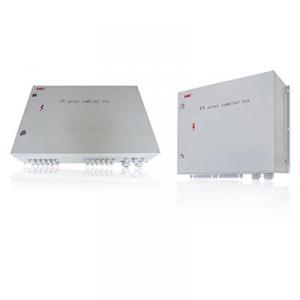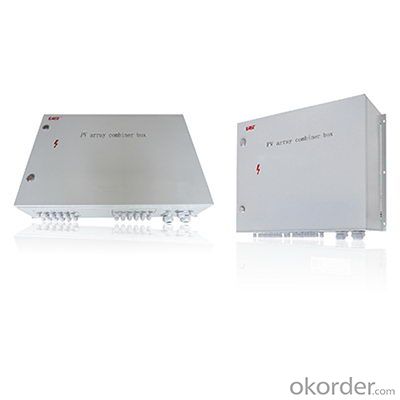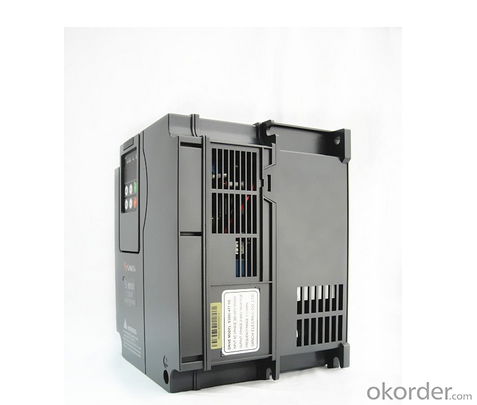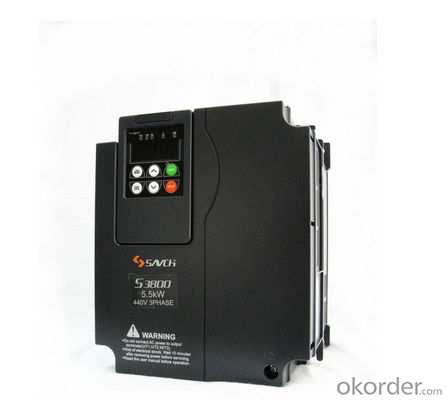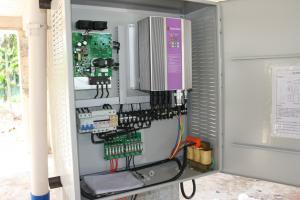Solar Inverter Rack - On-Grid PV Combiner Box for Easy Maintenance and Enhanced Reliability
- Loading Port:
- China main port
- Payment Terms:
- TT or LC
- Min Order Qty:
- 10 carton
- Supply Capability:
- 20000 carton/month
OKorder Service Pledge
OKorder Financial Service
You Might Also Like
EAPVCB-08/16/18S
To reduce the connection cables between the PV modules and solar inverters, to maintain easily, and improve reliability, in the large-scale photovoltaic power plants of on grid system, it’s necessary to use DC combining device between PV modules and solar inverters. EAPVCB Series PV array combiner box is specifically designed for high performance and high reliability, working with the PV inverter products from East Power to form complete photovoltaic system solutions. With PV array combiner box, and based on the PV inverter input voltage range, users can use certain numbers of PV panels with same specification in serially to form a PV module and connect several PV modules into the combiner box, and going through the SPD and breaker to output, which makes it easier to connect with inverter and also reduced the system installation time.
● Water protection level is IP65 for outdoor installation
● Wide range of DC input voltage (Max input open voltage can be up to 1000V)
● Dedicated photovoltaic fuses are used in each input,can bear DC1000V,fuse current can be selected
● Each input fuse is with a fuse holder, easy to replace and repair.
● Special high-voltage PV SPD is used,both positive and negative circuit can be protected
● Golden Sun and CE certifications
Model | EAPVCB8S | EAPVCB16S | EAPVCB-18S | |
Max PV array voltage | 1000V | 1000V | 1000V | |
Max input ways | 8 | 16 | 18 | |
Fuse rated current | Depending on customer's requirement | |||
Output terminal | PG29 | |||
Protection level | IP65 | |||
Environment temperature | -25℃~+60℃ | |||
Humidity | 0~99% | |||
W×H×D | 700×575×230mm | |||
Weight | 26Kg | 30Kg | 30Kg | |
Standard configuration | ||||
DC output breaker | Yes | Yes | Yes | |
PV-specific lightning protection module | Yes | Yes | Yes | |
Anti-reverse diode module | No | No | No | |
Diffuser | No | No | No | |
Fan | No | No | No | |
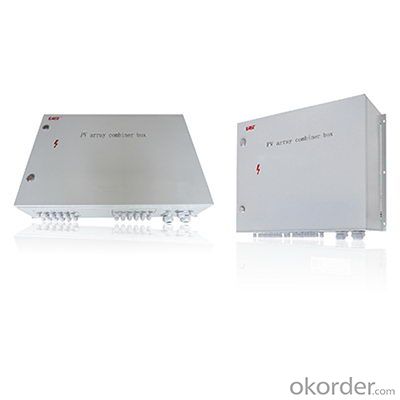
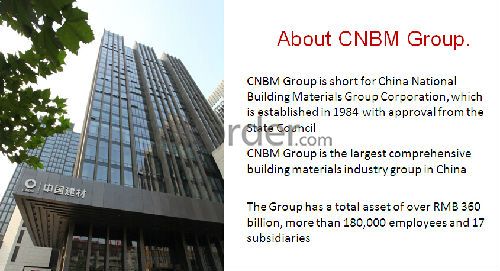
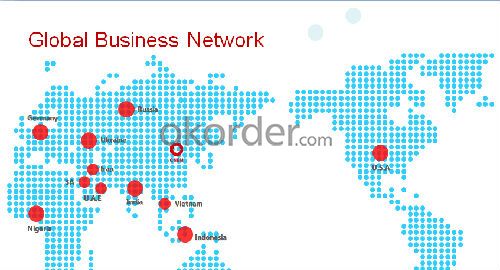
· Q. What's lifetime of a UPS ?
Most plug-in UPS are workable for at least five years. We'd advise you to change the batteries every three to four years. For larger equipment, we maintain equipment for twenty years old and still going strong.
· Q. How to maintain a UPS ?
There are three simple methods: Never overload your UPS, never connect any home electronic devices such as cooling fan to your UPS. This may cause malfunction of your UPS. Discharge the battery in a consistent interval, once a month or once two months. You can do this by turning on the UPS without connecting the mains.
- Q: What are the potential risks of electrical shock from a solar inverter?
- The potential risks of electrical shock from a solar inverter include direct contact with live electrical components, inadequate insulation or grounding, improper installation or maintenance, and failure to follow safety guidelines. Electrical shocks can cause injury, burns, and even fatalities. It is crucial to ensure proper precautions are taken, such as using qualified electricians, following manufacturer instructions, and implementing safety measures to mitigate these risks.
- Q: What is the typical installation process for a solar inverter?
- The typical installation process for a solar inverter involves several steps. First, the inverter is mounted in a suitable location, usually close to the solar panels and near the electrical service panel. Then, the DC input wires from the solar panels are connected to the DC input terminals on the inverter. The AC output terminals of the inverter are then connected to the electrical service panel, allowing the generated electricity to be fed into the grid or used by the household. Finally, the inverter is connected to a monitoring system, which enables the user to track the performance and energy production of the solar system. It is important to note that the installation process may vary depending on the specific inverter model and the local electrical codes and regulations.
- Q: What is the role of a surge protector in a solar inverter?
- The role of a surge protector in a solar inverter is to safeguard the inverter and connected electrical equipment from voltage spikes and power surges that can occur due to lightning strikes, grid fluctuations, or other electrical disturbances. It helps to prevent damage to the inverter and ensures the stability and longevity of the solar power system.
- Q: How do you choose the right output voltage for a solar inverter?
- When choosing the right output voltage for a solar inverter, it is crucial to consider the specific requirements of the electrical appliances or systems that will be powered by the inverter. The output voltage must match the voltage requirements of the devices to ensure compatibility and efficient operation. Additionally, the local electrical grid standards and regulations should be taken into account, as certain regions may have specific voltage requirements. It is advisable to consult with a professional or an electrician who can assess the specific needs and provide guidance in selecting the appropriate output voltage for the solar inverter.
- Q: What are the safety considerations when installing a solar inverter?
- When installing a solar inverter, there are several important safety considerations to keep in mind. Firstly, it is crucial to ensure that the power supply to the inverter is completely disconnected before beginning the installation process. This helps to prevent any electrical shocks or accidents. Additionally, it is important to follow the manufacturer's instructions and guidelines precisely to ensure a safe installation. Another key safety consideration is to make sure that the inverter is properly grounded to prevent the risk of electrical faults or fires. Finally, it is advisable to work with a qualified and experienced electrician to ensure that the installation is done correctly and in compliance with local electrical codes and regulations.
- Q: How does a solar inverter handle voltage and frequency variations caused by sudden load changes?
- Efficient and reliable, a solar inverter is specifically engineered to manage fluctuations in voltage and frequency resulting from sudden changes in load. When such changes occur, the solar inverter effectively employs a variety of control mechanisms to regulate and stabilize the output voltage and frequency. To begin with, the inverter continuously monitors the incoming solar power, keeping a close eye on the voltage and frequency. If any variations arise due to sudden load changes, the inverter promptly adjusts its internal control systems to compensate. Utilizing advanced power electronics and control algorithms, the inverter ensures that the voltage and frequency remain within the desired range. In order to handle voltage fluctuations caused by sudden load changes, the solar inverter utilizes a technique known as voltage regulation. It automatically adjusts the output voltage, either raising or lowering it as necessary. This guarantees that the inverter delivers a steady and consistent voltage supply to the load, effectively preventing any harm or malfunction. Similarly, to address frequency variations brought on by sudden load changes, the solar inverter employs a technique called frequency regulation. It adjusts the output frequency to match the grid frequency or meet specific frequency requirements. By maintaining the desired frequency, the inverter ensures compatibility and synchronization with the grid or other connected devices. In addition to voltage and frequency regulation, solar inverters also incorporate protective features to handle sudden load changes. They are equipped with built-in overload protection mechanisms capable of detecting excessive loads and preventing damage to both the inverter and the connected devices. These protective features may include safeguards such as overcurrent protection, short-circuit protection, and temperature monitoring. In summary, a solar inverter is purposefully designed to effectively manage voltage and frequency variations arising from sudden load changes. Through its voltage and frequency regulation capabilities, as well as its protective features, the inverter ensures stable and reliable operation. This enables the inverter to adapt efficiently to changing load conditions while safeguarding the integrity of the power supply.
- Q: What are the communication protocols used in solar inverters?
- Solar inverters commonly use several communication protocols to enable communication with other devices or systems. Some of the most frequently employed communication protocols in solar inverters include: 1. Modbus: Modbus is an extensively utilized communication protocol for industrial devices, including solar inverters. It facilitates the transmission of data between the inverter and other devices, such as monitoring systems or data loggers. Modbus is well-regarded for its simplicity and flexibility, which contribute to its popularity in the solar industry. 2. SunSpec: SunSpec is a communication protocol specifically designed for the solar industry. It establishes a standardized means for solar inverters to communicate with other devices, such as smart meters or monitoring systems. SunSpec supports both wired and wireless communication, allowing for effortless integration of solar inverters into larger energy management systems. 3. CAN bus: CAN (Controller Area Network) bus is a widely employed communication protocol in various industries, including automotive and industrial applications. It is a robust and reliable protocol that enables high-speed communication between devices. Some solar inverters employ CAN bus to communicate with other devices or systems, ensuring a dependable means of data transfer. 4. Ethernet: Ethernet is a prevalent communication protocol in the IT industry and is also utilized in certain solar inverters. By utilizing Ethernet, solar inverters can communicate with other devices or systems over a local area network (LAN) or the internet. Ethernet offers high-speed communication and can accommodate various communication standards, making it a versatile option for solar inverters. It is essential to note that different solar inverter manufacturers may employ different communication protocols or a combination thereof. The selection of a communication protocol depends on factors such as the specific requirements of the system, compatibility with other devices or systems, and the desired level of integration.
- Q: How does a solar inverter handle voltage dips and swells?
- A solar inverter is designed to handle voltage dips and swells by constantly monitoring the grid voltage. When a dip or swell occurs, the inverter's control system adjusts the output voltage accordingly to maintain a stable output. This is done through the use of power electronics and control algorithms that regulate the voltage and frequency of the inverter's output.
- Q: What is the role of a solar inverter in fault ride-through capability?
- The role of a solar inverter in fault ride-through capability is to help maintain the stability and reliability of the power grid during faults or disturbances. By detecting and responding to voltage and frequency variations caused by faults, the solar inverter can adjust its output and remain connected to the grid, ensuring continuous power supply. This capability is essential for grid stability and allows solar power systems to contribute to the overall reliability of the electrical network.
- Q: What are the potential risks of fire or explosions from a faulty solar inverter?
- The potential risks of fire or explosions from a faulty solar inverter include electrical malfunctions, overheating, short circuits, and insulation failures. These issues can lead to the accumulation of heat and energy, causing fires or explosions. Additionally, if the faulty inverter fails to properly regulate the flow of electricity, it can damage connected electrical devices or even cause electrocution hazards. Regular maintenance and inspections are crucial to minimize these risks and ensure safe operation of solar inverters.
Send your message to us
Solar Inverter Rack - On-Grid PV Combiner Box for Easy Maintenance and Enhanced Reliability
- Loading Port:
- China main port
- Payment Terms:
- TT or LC
- Min Order Qty:
- 10 carton
- Supply Capability:
- 20000 carton/month
OKorder Service Pledge
OKorder Financial Service
Similar products
Hot products
Hot Searches
Related keywords
